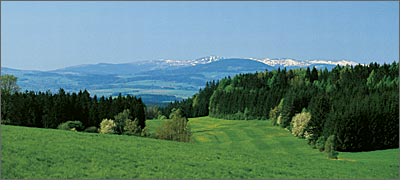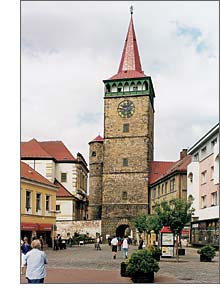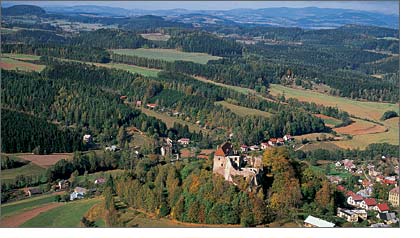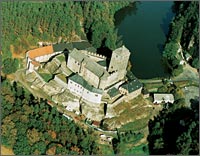Jičín and Surroundings
 Jičín, a town with a population of almost 17 000, is the gateway to the Český ráj (Bohemian Paradise). The locality is first mentioned as an estate
in a charter of the queeen Guta from August 1, 1293. The locality developed into a town at the turn of the 13th and 14th centuries and the fact is first documented
in the year 1304. Its name was probably derived from the fact that it was the property of queen Jitka, hence Jitka´s estate, Jitka´s town and later Jičín.
Jičín, a town with a population of almost 17 000, is the gateway to the Český ráj (Bohemian Paradise). The locality is first mentioned as an estate
in a charter of the queeen Guta from August 1, 1293. The locality developed into a town at the turn of the 13th and 14th centuries and the fact is first documented
in the year 1304. Its name was probably derived from the fact that it was the property of queen Jitka, hence Jitka´s estate, Jitka´s town and later Jičín.
Through the centuries the town had several different owners. Among them the house of Trčka contributed most to its development and the generalissimus of the Austrian imperial army Albrecht of Wallenstein had great plans for its reconstruction at the beginning of the 17th century. With the assistance of Italian architects he decided to turn it into the principal town of his Frýdlant estate. He had the originally Renaissance castle rebuilt into an early Baroque residence, joined with the park Libosad and a Baroque loggia through a two-kilometre long four-line linden-tree avenue. He also had the Valdice Carthusian monastery built and initiated the construction of a number of other notable buildings. The Jičín of Wallenstein turned into a center of learning. In 1624 one of the oldest grammar schools in Bohemia was opened there. He minted his own coins there, the magnificent Baroque St. James church was built, the Jičín Nové Město (New Town) was founded and among the projects there was also a bishopric.
 In the year 1956 the historical centre of Jičín was given the status of urban protected reserve of a number of well-preserved buildings and cultural
monuments - the Wallenstein castle, the Valdice Gate, the Jesuit College, the St. James and St. Ignatio churches or the Jewish Synagogue. Inside the reconstructed castle
in the main square there is the district museum and an art gallery.
In the year 1956 the historical centre of Jičín was given the status of urban protected reserve of a number of well-preserved buildings and cultural
monuments - the Wallenstein castle, the Valdice Gate, the Jesuit College, the St. James and St. Ignatio churches or the Jewish Synagogue. Inside the reconstructed castle
in the main square there is the district museum and an art gallery.
Jičín was the place where many famous personalities of science and culture gained their education. Among others it was the fairy-tale author Josef Štefan Kubín and the Austrian writer Karl Kraus. The most popular figure is however Václav Čtvrtek who spent his childhood there and drew inspiration from the local atmosphere for his fairy-tale character of the highwayman Rumcajs, visualised by Radek Pilař. Thanks to its charming surroundings and to its tradition, Jičín indeed has a unique fairy-tale atmosphere and that is why in mid-September every year, the whole town lives by the customary one-week festival Jičín - a Fairy Tale Town.
It is nevertheless not only Český ráj and the Prachovské skály stone formations, that represent a major tourist and alpinist centre, and the fairy-tale Jičín what the area can offer. To the west of Jičín there is the picturesque town of Sobotka and its dominant feature - the castle Humprecht. The beauty of that place is multiplied by the presence of the medieval castle Kost and the village Vesec which is an example of well-preserved original folk architecture.
The center of the south-eastern part of the area is in the „town of beauty in stone“ - Hořice v Podkrkonoší. It is most frequently remembered in connection with the sculptures in the local stone - the Hořice sandstone, and with the gallery at the foot of the hilll Gothard which presents a historical survey of the best sculptures in stone. Far beyond the borders of of the district reaches though the fame of the local pastry the „Hořice cream horns“ that are still made there.

A town in that area with quite distinctive charm is Nová Paka. In the local brewery the Novopacké beer has been made for decades and the brewery even has its own pond with a wasserman. This legend gave rise to the tradition of the „Nová Paka wasserman fair“ which takes place regularly at the beginning of September. You can also find there the world-famous Treasure house of precious stones, including an exhibition of the history of the local spiritist movement.
Another interesting sight is the castle Pecka whose most famous proprietor was Kryštof Harant of Polžice and Bezdružice who was one of the 27 nobles executed in the year 1621. In the surroundings of Jičín there are also some spas, namely Lázně Bělohrad and Železnice, suitable for patients with diseases of the locomotory system.
Suggestions for sightseeing and visists
|
 |